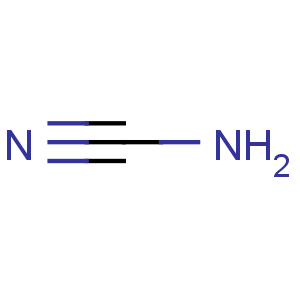Title: Cyanamide
CAS Registry Number: 420-04-2
Synonyms: Carbodiimide; hydrogen cyanamide; carbimide; cyanogenamide; amidocyanogen
Molecular Formula: CH2N2
Molecular Weight: 42.04
Percent Composition: C 28.57%, H 4.80%, N 66.64%
Line Formula: H2NCoN
Literature References: Prepd commercially by continuous carbonation of calcium cyanamide in water.
Ref. "Cyanamide," Process Chemicals Dept., Am. Cyanamid (New York, 1959) p 19. Acute toxicity data: J. Doull
et al., Survey of Compounds for Radiation Protection (AD277689, USAF Radiation Lab., 1962) 124 p.
Properties: Deliquescent, orthorhombic, elongated, six-sided tablets from dimethyl phthalate. d420 1.282. mp 45-46°. bp0.5 83°. Formn of dicyandiamide begins at 122°. Dipole moment in benzene at 20°: 3.8. Cryoscopic constant (water) 26.8-28.4. Sp ht 0.547 cal/g/°C between 0° and 39°. Heat of formation 14.05 kcal/mole (25°); heat of combustion -176.4 kcal/mole (25°); heat of fusion 2.1 kcal/mole. Heat of vaporization 16.4 kcal/mole. Soly (g/100 g soln) in water at 15°: 77.5, at 43°: 100; in butanol at 20°: 28.8, in methyl ethyl ketone: 50.5, in ethyl acetate: 42.4. Sol in alcohols, phenols, amines, ethers, ketones. Very sparingly sol in benzene, halogenated hydrocarbons. Practically insol in cyclohexane. Solid cyanamide should be stored in a cool, dry place. Polymerizes at 122°. Optimum pH for storage of solns is ~4. Attacks various metals. Solns can be stored in glass provided they are stabilized with phosphoric, acetic, sulfuric, or boric acid. LD50 i.p. in male mice: 200-300 mg/kg (Doull).
Melting point: mp 45-46°
Boiling point: bp0.5 83°
Density: d420 1.282
Toxicity data: LD50 i.p. in male mice: 200-300 mg/kg (Doull)
NOTE: Term "cyanamide" is also used to designate calcium cyanamide.
CAUTION: Potential symptoms of overexposure are irritation of eyes, skin, respiratory system; eye, skin burns; miosis, salivation, lacrimation, twitching; Antabuse-like effects.
See NIOSH Pocket Guide to Chemical Hazards (DHHS/NIOSH 97-140, 1997) p 80.

